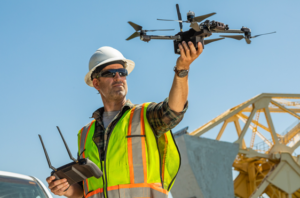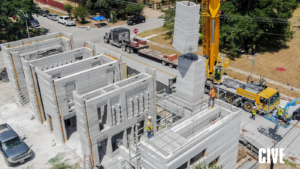Here are some of the trends in construction management to watch out for in 2024:
BIM/DIM and the Benefits to Construction
Building Information Modeling (BIM) and Digital Information Modeling (DIM) are technologies that allow project teams to create, share and manage digital representations of physical and functional characteristics of buildings and infrastructure. BIM/DIM can help improve collaboration, coordination, communication, quality, efficiency, productivity and sustainability in construction projects. Some of the benefits of BIM/DIM include:
– Reducing errors, rework and waste by detecting clashes and inconsistencies early
– Enhancing design quality and creativity by enabling visualization and simulation
– Optimizing cost and schedule by enabling data-driven decision making and automation
– Improving safety and performance by enabling risk assessment and mitigation
– Increasing transparency and accountability by enabling data sharing and tracking
– Supporting sustainability and circularity by enabling embodied carbon calculation and material optimization
According to a report by Autodesk, BIM adoption is expected to grow from 58% in 2019 to 79% in 2024, while DIM adoption is expected to grow from 13% in 2019 to 36% in 2024.
Connected Construction Site and How It Improves Site Efficiency
A connected construction site is a site that leverages the Internet of Things (IoT), cloud computing, artificial intelligence (AI), machine learning (ML), big data analytics, augmented reality (AR), virtual reality (VR) and other technologies to collect, process, analyze and visualize data from various sources such as sensors, cameras, drones, robots, wearables, equipment, materials and workers. A connected construction site can help improve site efficiency by:
– Enhancing situational awareness and visibility by enabling real-time monitoring and reporting
– Improving resource management and utilization by enabling smart scheduling and allocation
– Boosting productivity and quality by enabling automation and optimization
– Reducing downtime and delays by enabling predictive maintenance and troubleshooting
– Enhancing safety and security by enabling hazard detection and prevention
According to a report by Epicflow, the global market for IoT in construction is expected to grow from $7.8 billion in 2019 to $16.8 billion in 2024.
Using Drones to Enhance Worker Safety and Track Progress
 Drones are unmanned aerial vehicles that can fly autonomously or remotely controlled. Some drones can be equipped with cameras, sensors, scanners, lasers, GPS, RFID tags and other devices to capture data from the air. Drones can help enhance worker safety and track progress in construction projects by:
Drones are unmanned aerial vehicles that can fly autonomously or remotely controlled. Some drones can be equipped with cameras, sensors, scanners, lasers, GPS, RFID tags and other devices to capture data from the air. Drones can help enhance worker safety and track progress in construction projects by:
– Inspecting hard-to-reach or hazardous areas such as roofs, bridges, tunnels, scaffolds, cranes and pipelines
– Surveying large or complex sites such as highways, railways, dams, airports and stadiums
– Mapping terrain features such as topography, elevation, contours and boundaries
– Measuring dimensions such as length, width, height, area and volume
– Documenting progress such as completed work, defects, deviations and changes
– Communicating information such as images, videos, reports and alerts
According to a report by StartUs Insights, the global market for drones in construction is expected to grow from $4.5 billion in 2018 to $11.2 billion in 2024.
Using Robotics in Construction and Outline Types of Robots and Their Use
Robotics is the science and technology of designing, building, programming and operating robots. Robots are machines that can perform tasks that are difficult, dangerous or repetitive for humans. Robots can help improve efficiency, quality, safety and sustainability in construction projects. Some of the types of robots and their use in construction include:
– Demolition robots: robots that can break down concrete, brick or metal structures using hammers, saws or explosives
– Bricklaying robots: robots that can lay bricks or blocks using mortar or adhesive
– Welding robots: robots that can join metal parts using heat or pressure
– Painting robots: robots that can apply paint or coating on surfaces using sprayers or rollers
– Concrete printing robots: robots that can extrude concrete layers to form complex shapes or structures
– Assembly robots: robots that can assemble prefabricated components or modules using cranes or manipulators
According to a report by ResearchAndMarkets.com, the global market for robotics in construction is expected to grow from $22.7 million in 2018 to $226.5 million in 2025.
Creating a Digital Twin of the Project and How It Helps Identify Potential Problems and Offers Solutions
A digital twin is a virtual replica of a physical asset, system or process that can be updated and synchronized with the real one using data from sensors, cameras, drones, robots, wearables, equipment, materials and workers. A digital twin can help identify potential problems and offer solutions in construction projects by:
– Simulating scenarios such as weather, traffic, load, stress and strain
– Testing hypotheses such as design alternatives, material choices and construction methods
– Optimizing outcomes such as cost, schedule, quality and performance
– Detecting issues such as errors, defects, deviations and failures
– Resolving conflicts such as clashes, changes and disputes
– Learning from experience such as feedback, lessons and best practices
According to a report by MarketsandMarkets, the global market for digital twin in construction is expected to grow from $3.1 billion in 2020 to $48.2 billion in 2026.
3D Printing and How It Helps With the Labor Shortage and Speeds Up the Construction Process
 3D printing is a technology that can create physical objects from digital models by depositing layers of material on top of each other. The concept of 3D printing can help with the labor shortage and speed up the construction process by:
3D printing is a technology that can create physical objects from digital models by depositing layers of material on top of each other. The concept of 3D printing can help with the labor shortage and speed up the construction process by:
– Reducing labor requirements by enabling automation and customization
– Increasing labor productivity by enabling precision and accuracy
– Enhancing labor skills by enabling training and education
– Reducing material waste by enabling optimization and recycling
– Increasing material diversity by enabling innovation and experimentation
– Enhancing material performance by enabling functionality and durability
According to a report by Grand View Research, the global market for 3D printing in construction is expected to grow from $4.5 million in 2019 to $1.5 billion in 2027.
Growing Legal Trends in Construction
The construction industry is also facing some growing legal trends that will affect the way projects are planned, executed and delivered. Some of the legal trends to watch out for in 2024 include:
– Contract clauses that address supply chain disruptions, inflation risks and cyber threats
– Dispute resolution methods that leverage online platforms, mediation and arbitration
– Liability issues that arise from design errors, construction defects and environmental impacts
– Regulatory compliance that requires adherence to safety standards, building codes and sustainability goals
– Intellectual property rights that protect data, designs and innovations
According to a report by Construction Dive, some of the legal trends that emerged in 2023 will continue to shape the industry in 2024.
Conclusion
The construction industry is undergoing a digital transformation that will bring new opportunities and challenges for construction managers. By staying updated on the latest trends and innovations, construction managers can leverage the power of technology to improve their project outcomes and gain a competitive edge in the market.






